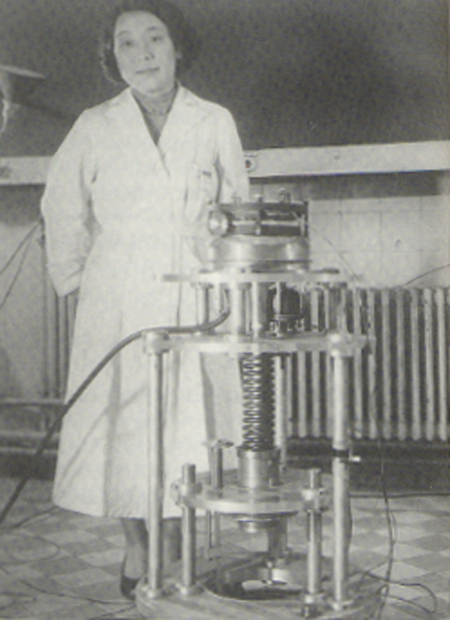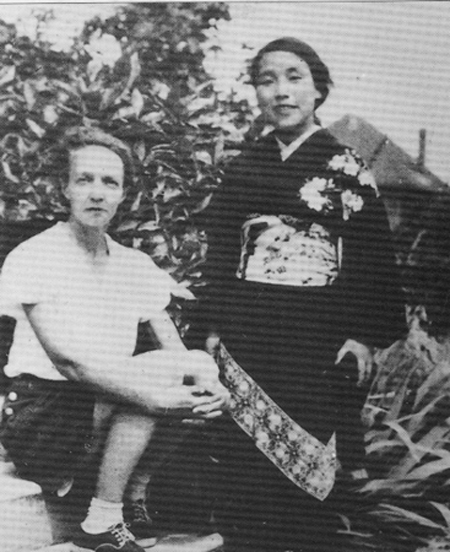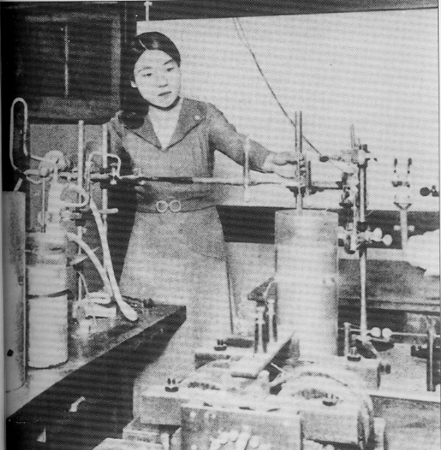 Toshika Yuasa in her lab in Paris after 1959. A PASSION FOR SCIENCE BEYOND PLACE AND TIME
Yuasa Toshiko, 1909-1980
Nuclear Physicist
by Miwae Yamazaki
The story of Toshiko Yuasa is a drama spanning two
continents and a world war. Though held back by prejudice at home and by war
in Europe, she remained totally dedicated to her research in nuclear
physics, even designing her own lab equipment. Honored not only in France,
where she made her home, but around the world, she worked tirelessly to
forge closer scientific ties between her native and adopted
countries.
THE PATH TO THE TRUTH
Born in the Ueno district of Tokyo in 1909, Toshiko Yuasa was
the sixth of seven children. Her father was an engineer and the inventor of
a machine for automatically reeling raw silk from cocoons. Toshiko used to
listen entranced as her father spoke to the children of Newton, Einstein,
and other great scientists. Her mother, meanwhile, came from a long line of
poets in the Japanese tradition, and she taught Toshiko Japanese verse and
other aspects of traditional culture, fostering in her a refined aesthetic
sensibility. Toshiko was also an extremely curious young girl, always
determined to get to the bottom of everything going on around her.
In higher school, she excelled in every subject, from
literature to mathematics. But when she entered the Tokyo Women's Higher
Normal School, she decided that science was the path to the truth that lay
at the heart of nature in all its beauty and wonder. When she entered the
physics department of Tokyo University of Literature and Science in 1931,
she became Japan's first woman university student to major in physics.
When Yuasa graduated from the university in 1934, she stayed
on as a teaching assistant and set to work studying the light spectrum
emitted by different atoms and molecules to better understand their
structure and properties. Increasingly, however, she found her progress
blocked by the prejudices of those around her—most of whom refused to
believe that a woman could accomplish anything of importance in the field of
science—and her frustration grew. Then one day she came across a
research paper detailing the discovery of artificial radioactivity by Irène
and Frédéric Joliot-Curie, the daughter and son-in-law of Marie Curie. Marie
Curie had discovered radium, a natural radioactive element that emits
particles from its nucleus, thereby transforming into a different element.
The Joliot-Curies had discovered that it was possible to create such
elements artificially. Although an associate professor at the Tokyo Women's
Higher Normal School, Yuasa was so impressed with the Joliot-Curies'
research methods that she made up her mind to work under the husband-wife
team. She set out to study in France under the sponsorship of the French
government just months after the outbreak of World War II. Yuasa was 30
years old.
 Toshiko Yuasa (right) with Irene Joliot-Curie at the Joliot-curies' home outside of Paris in 1941. PERILS OF WAR
Arriving in Paris at the beginning of March 1940, she found
the city under martial law and the research institutes closed to foreigners.
Nonetheless, the Joliot-Curies, moved by Yuasa's determination and
enthusiasm, made it possible for her to begin her research into atomic
nuclei under their direction at the Nuclear Chemistry Laboratory of the
Collège de France. "I feel like my soul has found freedom at this
laboratory," Yuasa wrote, "where the words 'I want to do research' carry
more weight than anything else, and no one is discriminated against because
of gender or nationality."
Just a few months later, Yuasa's work was brought to an
abrupt halt as Paris came under German occupation. The laboratory was closed
down, and Yuasa was forced to flee from Paris. With no means of support, she
found herself facing abject poverty. One thing that helped her through these
hard times was her relationship with the JoliotCuries, who believed in her
and admired her love of learning and her earnest attitude toward life. The
other thing that kept her going was the image of Marie Curie, the ideal
woman scientist, with whom she felt she enjoyed a connection through the
Joliot-Curies.
Yuasa began to do cutting-edge research on beta decay in
artificial radioactive isotopes. She hoped to shed light on the process
whereby an atom emits a beta particle (electron) and turns into a different
element by observing and analyzing beta rays with a Wilson cloud chamber, an
apparatus in which the path of emitted particles is made visible. As the
result of a long series of careful observations, Yuasa was able to make an
important contribution to our understanding of the process of beta decay, a
topic of keen interest to scientists around the world at that time. In
recognition of her important work, Yuasa was awarded the French national
degree of doctor of science in late 1943.
In August 1944, with the Allies on the verge of liberating
Paris, Yuasa was transferred to Berlin at the urging of the government of
Japan, Germany's ally. Once again, through sheer sincerity, enthusiasm, and
persistence, Yuasa was able to find a position at a research facility
attached to the University of Berlin, where she went to work each day even
as air raids pounded the city. In the midst of this turmoil, she succeeded
in creating a new type of apparatus for measuring beta rays. After Germany's
surrender in May 1945, she took her invention and returned to Japan by way
of Siberia, just a month and a half before Japan's surrender.
TOKYO, PARIS, AND THE WORLD
After World War II, Japan came under U.S. occupation, and one
of the first things the Occupation authorities did was to prohibit nuclear
research. Although Yuasa was involved in basic research that had no
application to nuclear weapons, she found herself unable to continue her
work. Appointed professor at Tokyo Women's Higher Normal School, she devoted
herself to teaching, became actively involved in plans for establishing a
new national women's university (together with Kono Yasui), and was
unstinting in her assistance to younger colleagues. Still, her passion for
research was not to be denied. In February 1949, at the Joliot-Curies'
invitation, she returned to France.
As a researcher attached to the French National Center for
Scientific Research (CNRS), she once again started work at the Collège de
France, observing beta decay to better understand the energy structure of
atomic nuclei. In 1955, making up her mind to continue her work in France,
she retired from her post at Ochanomizu University (formerly Tokyo Women's
Higher Normal School). Immediately after this decision, tragedy struck as
her dear friend and mentor, Irène Joliot-Curie died, followed quickly by her
husband. Ultimately, though, this loss only strengthened Yuasa's dedication
to her work, while giving her a new and deeper appreciation of human
life.
In 1959, when the center moved to Orsay, just south of Paris,
the focus of Yuasa's research shifted as well. She began to explore the
structure and dynamics of atomic nuclei by observing what occurs when the
nucleus of a carbon atom, for example, is bombarded with a proton
accelerated to high speed using a cyclotron. To secure regular use of the
cyclotron and other large-scale apparatuses shared by the center's
researchers, Yuasa had to argue her case forcefully. In order to carry out
pioneering experiments, she designed her own observation equipment. Tackling
the most complex and advanced research problems with amazing energy, Yuasa
became one of the center's most valued scientists. Scientists around the
world hailed her findings and invited her to speak at international
conferences on nuclear physics. She returned to Japan only twice—once
in 1967 and again in 1977—to participate in international conferences,
staying about two months on each occasion. But she worked hard to promote
scientific exchange between Japan and France, as by inviting young Japanese
scientists to Orsay to participate in joint research projects.
 Conducting a molecular spectorscopy experiment at Tokyo University of Literature and Science, ca. 1934. RIGOROUSLY TO THE VERY END
In 1973, Yuasa underwent surgery for stomach cancer, but her
commitment to scientific research never slackened, and she continued to
attend conferences around the world. Upon reaching retirement age in 1974,
she assumed the status of honorary researcher at CNRS. Yuasa remained
active, however, even as her physical condition worsened. She proposed a
joint Japanese-French research project to tackle the difficult subject of
few-nucleon systems, one of the hottest topics in physics. True to one of
her pet expressions, Yuasa pursued her goals "rigorously to the very end."
She died in February 1980, on the very day she learned that the project was
to go forward. It was taken over by Hélène Langevin-Joliot, the eldest
daughter of the Joliot-Curies, and Takuji Yanabu of Kyoto University, who
dedicated the paper reporting their findings to Toshiko Yuasa.
Yuasa once said that "the true spirit of scientific inquiry
extends to all things essential," and her life was a perfect illustration of
this principle. While conducting scientific research to get closer to the
essence of the physical world, she sought also to understand the essence of
art and literature, philosophy, and religion. In addition, she was a
genuinely concerned and caring person, and it was this aspect of her
character that drove her efforts to foster friendship between France and
Japan—efforts that gave rise to new avenues of interchange between the
two countries. This rich, multifaceted quality of Yuasa's life is
crystallized in such books as Paris Memoirs (in Japanese), which are
widely read.
In December 1995, Ochanomizu University hosted a Toshiko
Yuasa Memorial Conference. Although 15 years had passed since her death, the
conference hall was filled to overflowing with participants eager to honor
the memory of this pioneering woman physicist—testimony to the respect
and admiration that her life inspired, and continues to inspire, in so many
people. On this occasion, Hélène Langevin told the audience how
Yuasa, though facing death, had insisted on continuing her research, not for
herself "but for the advancement of science." This belief, said Langevin,
was the source of Yuasa's great energy and the guiding principle of her
life.
.........................
Ed. note: Miwae Yamazaki is a theoretical physicist. She graduated
first from Tokyo Women's Higher Normal School, where she majored in science,
and later from the physics department of Tokyo University of Literature and
Science. Beginning in 1945 she benefited from Yuasa's instruction and
guidance. Yamazaki is the editor of Toshiko Yuasa: Living in Paris (1995; in
Japanese). She now holds the title of professor emeritus of Saitama
University.
.........................
Reference
Yamazaki, Miwae. Blazing a Path: Japanese Women's Contributions to Modern Science, organized by The Committee for the Encouragement of Future Scientists. (See general references for full citation.)
|
